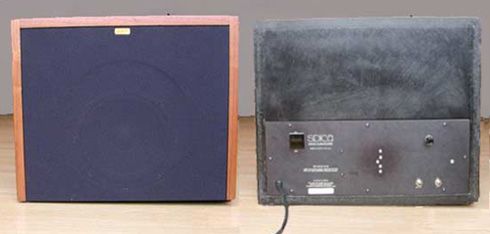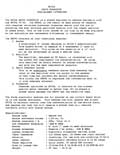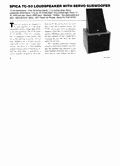The Spica Servo-Subwoofer was designed to extend the low frequency performance of the Spica TC-50 speaker system. Its computer-optimized crossover network, servo error correction circuit, specially designed 8" woofer, and internal 70 watt power amplifier all contribute to give a dramatic improvement in your system's clarity and definition, while allowing higher sound pressure levels to be obtained.

There were two variations of the servo sub produced. An early “70 watt” version pictured directly below (note vertical line of screws in the middle of the plate) and a later "50 watt" version. The electronics for both were designed by PS Audio and produced from the same schematics. The component layout in the later design was altered to make it easier to produce in volume and the literature changed to indicate a more conservative 50 watts. Early versions were built in-house by PS Audio, later versions were contracted out.
The servo sub was connected in-line between the pre-amp and amplifier by way of an external crossover/splitter interface. The interface contained a passive high-pass filter that removed (shunted) lower bass frequencies from the TC-50's while passing the full signal to the sub. The subs internal amp took care of removing the unwanted upper frequencies.
Unfortunately to construct a passive crossover the components of the filter had to be selected to mate with the input impedance of the users amplifier. To accomplish this, the original servo sub shipped with a project box and a handful of resistors and capacitors to construct your own. The manual contained the information and formulas needed to select the appropriate components to construct the filter. While not technically difficult, the process assumed you owned a soldering iron and had to be reworked if you changed your amplifier.
The project box approach wasn't well received by audio stores who couldn’t predict what amp a customer might want to hear mated with the Spica's. Spica later replaced the parts and box with a pre-constructed unit that used a switch to adjust the characteristics of the crossover to the client's amplifier.
Reviews
High Fidelity
Stereophile:
- February 1984, Spica Servo Subwoofer VII-2
- August 1986, Spica Servo Subwoofer IX-5
- September, 1986 Spica Servo Subwoofer IX-7,
- October 1989, Spica Servo Subwoofer XII-10
Specifications:
Released: 1985
Drive-unit: 8"
Description: 8" cone subwoofer in sealed module with 70-watt servo amplifier.
Crossover: High-pass Passive 1st order, -3dB @ 88Hz. (external adjustable)
Low-pass Electronic with computer driven slope
Nominal impedance: 110k Ohms open, 20k Ohms (w/shorting plug)
Polarity: Inverting, for use with non-inverting TC-50s
Level Contol: Continuously Variable, within a 12db range
Power Amplifier: 70 watts RMS minimum
Dimensions: 14.5"(36.8) H x 17.5 (44.5)" W x 15.875 (40.3)D
Weight: 40 lbs (18.25kg).
Price: $595 (Passive Crossover and Internal Servo Amplifier included)
Replacement Drivers:
(brand and model number needed)






